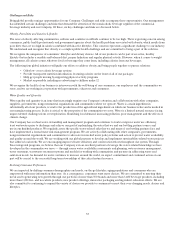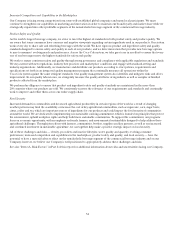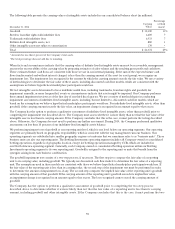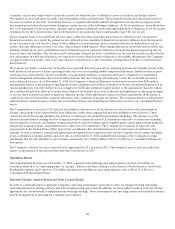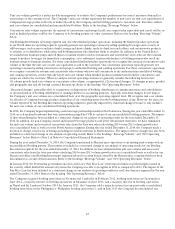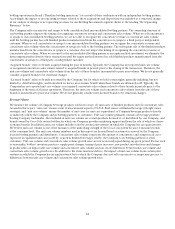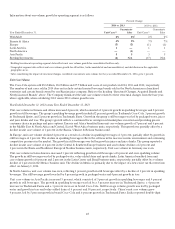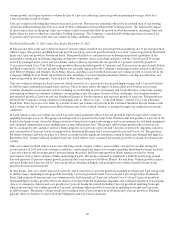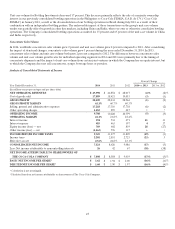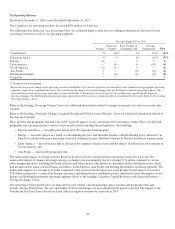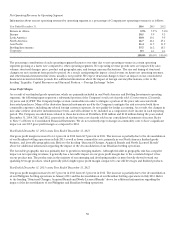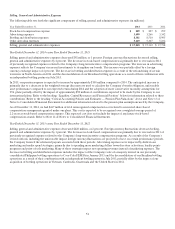Coca Cola 2014 Annual Report Download - page 45
Download and view the complete annual report
Please find page 45 of the 2014 Coca Cola annual report below. You can navigate through the pages in the report by either clicking on the pages listed below, or by using the keyword search tool below to find specific information within the annual report.43
Unit case volume growth is a metric used by management to evaluate the Company’s performance because it measures demand for
our products at the consumer level. The Company’s unit case volume represents the number of unit cases (or unit case equivalents) of
Company beverage products directly or indirectly sold by the Company and its bottling partners to customers and, therefore, reflects
unit case volume for consolidated and unconsolidated bottlers. Refer to the heading “Beverage Volume” below.
Concentrate sales volume represents the amount of concentrates and syrups (in all cases expressed in equivalent unit cases) sold by, or
used in finished products sold by, the Company to its bottling partners or other customers. Refer to the heading “Beverage Volume”
below.
Our Bottling Investments operating segment and our other finished product operations, including the finished product operations
in our North America operating segment, typically generate net operating revenues by selling sparkling beverages and a variety of
still beverages, such as juices and juice drinks, energy and sports drinks, ready-to-drink teas and coffees, and certain water products,
to retailers or to distributors, wholesalers and bottling partners who distribute them to retailers. In addition, in the United States,
we manufacture fountain syrups and sell them to fountain retailers such as restaurants and convenience stores who use the fountain
syrups to produce beverages for immediate consumption, or to authorized fountain wholesalers or bottling partners who resell the
fountain syrups to fountain retailers. For these consolidated finished product operations, we recognize the associated concentrate sales
volume at the time the unit case or unit case equivalent is sold to the customer. Our concentrate operations typically generate net
operating revenues by selling concentrates and syrups to authorized bottling and canning operations. For these concentrate operations,
we recognize concentrate revenue and concentrate sales volume when we sell concentrate to the authorized unconsolidated bottling
and canning operations, and we typically report unit case volume when finished products manufactured from the concentrates and
syrups are sold to the customer. When we analyze our net operating revenues we generally consider the following four factors:
(1) volume growth (unit case volume or concentrate sales volume, as appropriate), (2) structural changes, (3) changes in price, product
and geographic mix and (4) foreign currency fluctuations. Refer to the heading “Net Operating Revenues” below.
“Structural changes” generally refers to acquisitions or dispositions of bottling, distribution or canning operations and consolidation
or deconsolidation of bottling, distribution or canning entities for accounting purposes. Typically, structural changes do not impact
the Company’s unit case volume on a consolidated basis or at the geographic operating segment level. We recognize unit case volume
for all sales of Company beverage products regardless of our ownership interest in the bottling partner, if any. However, the unit case
volume reported by our Bottling Investments operating segment is generally impacted by structural changes because it only includes
the unit case volume of our consolidated bottling operations.
In 2014, the Company began implementing a new beverage partnership model in North America. During the year ended December 31,
2014, we refranchised territories that were previously managed by CCR to certain of our unconsolidated bottling partners. The impact
of this refranchising has been included as a structural change in our analysis of operating results for the year ended December 31,
2014. In addition, for non-Company-owned and licensed beverage products sold in the refranchised territories, we have eliminated
the unit case volume and associated concentrate sales from the base year when calculating 2014 versus 2013 volume growth rates
on a consolidated basis as well as for the North America segment. During the year ended December 31, 2014, the Company made a
decision to change our process of buying and selling recyclable materials in North America. The impact of these changes has also been
included as a structural change in our analysis of operating results. Refer to the headings “Beverage Volume” and “Net Operating
Revenues” below. Refer to Note 2 of Notes to Consolidated Financial Statements.
During the year ended December 31, 2014, the Company transitioned its Russian juice operations to an existing joint venture with an
unconsolidated bottling partner. This transfer is included as a structural change in our analysis of operating results for our Bottling
Investments segment for the year ended December 31, 2014. In addition, we have eliminated the unit case volume and associated
concentrate sales from the base year when calculating 2014 versus 2013 volume growth rates on a consolidated basis as well as for our
Eurasia and Africa and Bottling Investments segments related to certain brands owned by the Russian juice company that have been
discontinued as a result of this transition. Refer to the headings “Beverage Volume” and “Net Operating Revenues” below.
In January 2014, the Venezuelan government enacted a new law (“Fair Price Law”) that imposes limits on profit margins earned in
the country, which limited the amount of revenue the Company was able to recognize in 2014 as compared to 2013. The impact of the
Fair Price Law has been included as a structural change in our analysis of operating results for our Latin America segment for the year
ended December 31, 2014. Refer to the heading “Net Operating Revenues” below.
The Company acquired bottling operations in Vietnam and Cambodia in February 2012, bottling operations in Guatemala in
June 2012, a majority interest in bottling operations in Myanmar in June 2013, and a majority interest in bottling operations
in Nepal and Sri Lanka in October 2014. In January 2013, the Company sold a majority interest in our previously consolidated
bottling operations in the Philippines (“Philippine bottling operations”), and in July 2013 the Company deconsolidated our


